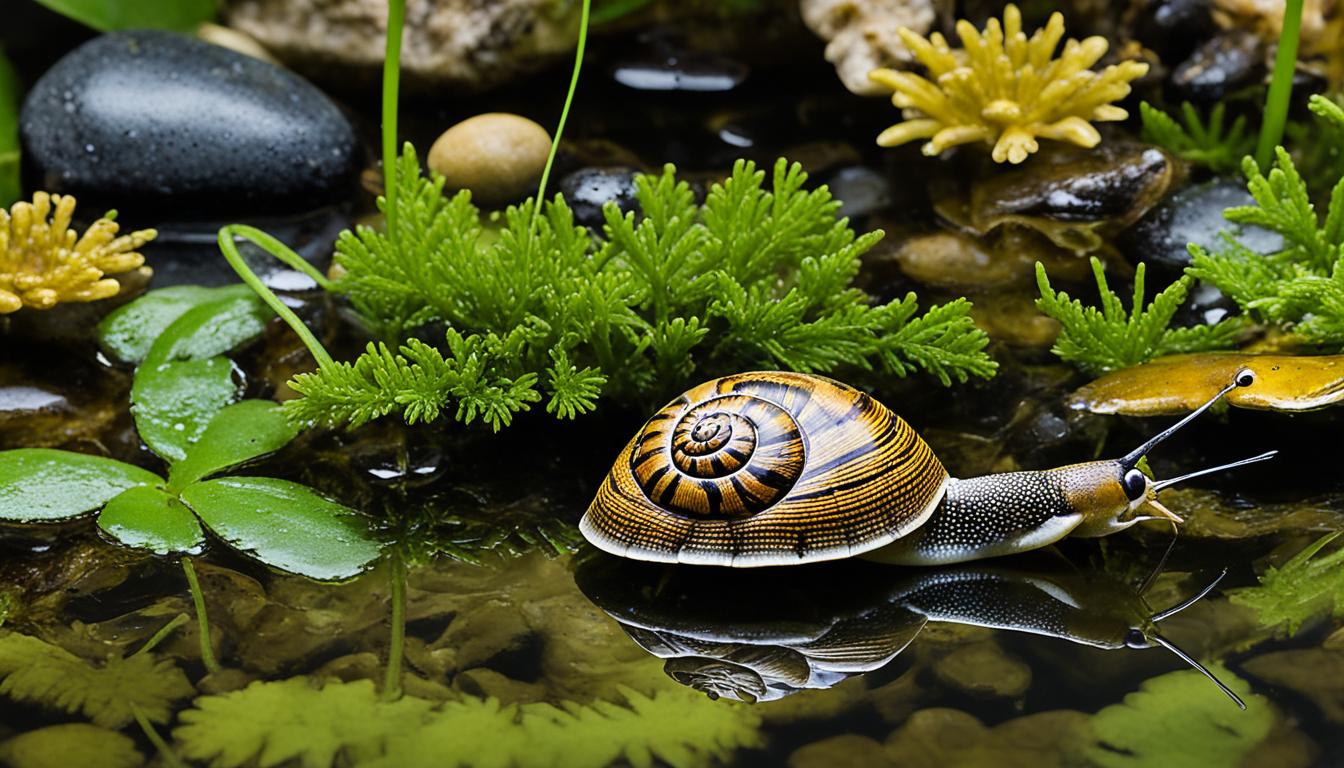Did you realize that freshwater environments, which only make up 1% of the Earth’s surface, are home to an impressive 10% of all known plants and animals? These aquatic ecosystems are bursting with life, including a diverse range of intriguing freshwater invertebrates. From snails to prawns and aquatic insects, these invertebrates are crucial in preserving the health and diversity of freshwater ecosystems.
Key Takeaways:
- Freshwater habitats, despite their small size, harbor 10% of all known species.
- Invertebrates such as snails, prawns, and aquatic insects are crucial for ecosystem health.
- Human activities have had a significant impact on the diversity of freshwater invertebrates.
- Monitoring freshwater invertebrates can help assess water quality and ecosystem functioning.
- Conservation efforts and public awareness are essential for protecting these valuable organisms.
The Importance of Freshwater Invertebrates in Aquatic Ecosystems
Freshwater invertebrates play a vital role in the functioning and health of aquatic ecosystems. These organisms contribute to essential ecosystem processes that are crucial for maintaining a balanced and sustainable environment. With their diverse adaptations and ecological roles, freshwater invertebrates are integral to the biodiversity and overall functioning of freshwater ecosystems.
Organic Matter Decomposition: Freshwater invertebrates are key contributors to the decomposition of organic matter in aquatic ecosystems. They feed on detritus and dead plant and animal material, breaking them down into smaller particles and facilitating the recycling of nutrients. Through their feeding activities, these invertebrates help release nutrients and maintain nutrient cycling in the ecosystem, supporting the growth of other organisms.
Water Filtration: Many freshwater invertebrates, such as filter-feeding mollusks and crustaceans, actively filter and consume suspended particles, algae, and organic matter from the water column. This process not only helps to clarify the water but also plays a crucial role in maintaining water quality. By removing excess nutrients, sediments, and pollutants, these invertebrates contribute to the overall purification of the aquatic environment.
Nutrient Cycling: Freshwater invertebrates are important players in the cycling of nutrients between aquatic and terrestrial ecosystems. As invertebrates consume organic matter from the water, they convert it into biomass. This biomass can then be consumed by predators, including fish and birds, and transferred to the terrestrial ecosystem through their droppings or carcasses. The nutrients released by freshwater invertebrates contribute to the fertility of surrounding soils and support the growth of terrestrial plants.
Energy Flow: Freshwater invertebrates serve as a vital energy source for higher trophic levels in aquatic ecosystems. They are prey for various organisms, including fish, amphibians, and birds, forming an essential part of the food web. The abundance and availability of freshwater invertebrates directly impact the population dynamics and reproductive success of these higher trophic levels.
Ecosystem Indicators: The presence and abundance of freshwater invertebrates can provide valuable insights into the overall health and well-being of aquatic ecosystems. As sensitive organisms, they are greatly affected by changes in water quality, habitat degradation, and pollution. Monitoring populations of freshwater invertebrates can serve as an indicator of ecosystem health and help identify potential threats to biodiversity and ecosystem functioning.
“Freshwater invertebrates contribute to essential ecosystem processes such as organic matter decomposition, water filtration, and nutrient cycling.”
| Freshwater Invertebrates | Ecosystem Contribution |
|---|---|
| Filter-feeding mollusks and crustaceans | Water filtration, nutrient recycling |
| Detritivorous invertebrates | Organic matter decomposition, nutrient cycling |
| Prey for higher trophic levels | Energy flow, supporting food webs |
| Indicator species | Ecosystem health assessment |
In conclusion, freshwater invertebrates play a vital role in maintaining the balance and health of aquatic ecosystems. Their contributions to organic matter decomposition, water filtration, nutrient cycling, energy flow, and ecosystem health assessment highlight the significance of these organisms. To ensure the conservation and preservation of freshwater invertebrates, it is essential to recognize their importance and take proactive measures to protect their habitats and the overall biodiversity of aquatic ecosystems.
Threats to Freshwater Invertebrates
Freshwater invertebrates, such as snails, prawns, and aquatic insects, face numerous threats that jeopardize their survival and the health of aquatic ecosystems. It is crucial to understand these threats in order to take necessary measures to protect these valuable organisms.
Water Pollution
One of the major threats to freshwater invertebrates is water pollution. Agricultural and urban activities contribute to the release of pollutants into freshwater systems, including harmful chemicals, pesticides, and fertilizers. Untreated sewage and wastewater also add to the pollution burden. These pollutants can have detrimental effects on the invertebrate populations, leading to declines in their numbers and compromising their reproductive abilities.
Habitat Destruction
The destruction of freshwater habitats poses another significant threat to invertebrates. Dam construction, channelization, and excessive sedimentation alter the natural flow of water, disrupt the ecosystems, and degrade the habitats where these organisms reside. Invasive species also contribute to habitat destruction by outcompeting native invertebrates for resources, further reducing their numbers and displacing them from their natural habitats.
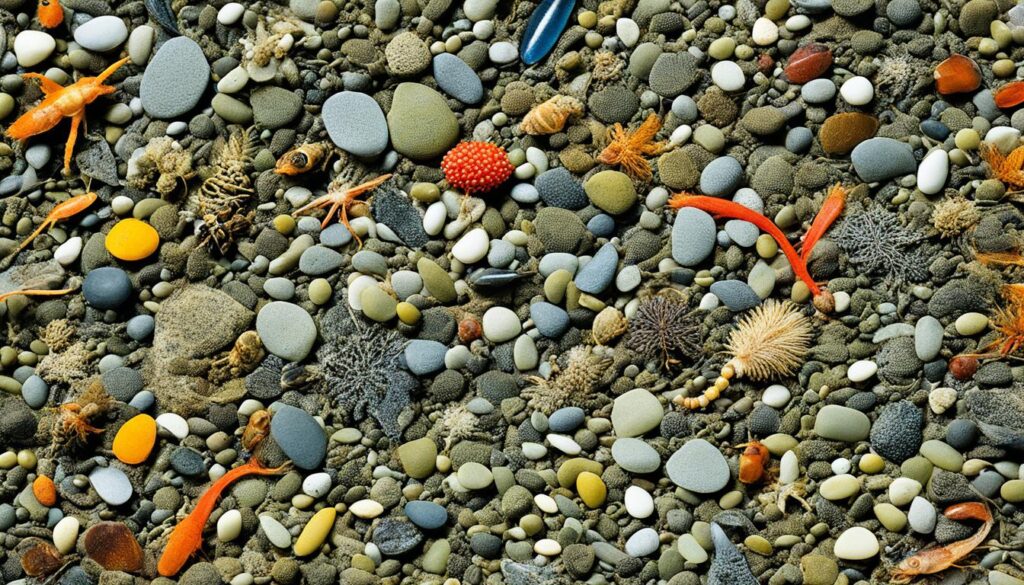
“Water pollution and habitat destruction have serious implications for freshwater invertebrates. These organisms are critical components of the ecosystem, playing key roles in nutrient cycling, decomposition, and overall ecosystem functioning. The loss of freshwater invertebrates can lead to imbalances in the ecosystem, affecting the entire food web and compromising water quality.”
Population Declines and Biodiversity Loss
As a result of the aforementioned threats, freshwater invertebrates experience declines in population size and loss of biodiversity. When these organisms decline, it disrupts the balance of the entire ecosystem. The loss of certain species can have cascading effects on other organisms, leading to a decline in overall biodiversity and the disruption of important ecosystem processes.
It is paramount to address these threats and implement conservation measures to safeguard freshwater invertebrates and maintain the health of aquatic ecosystems. By reducing water pollution, protecting and restoring habitats, and managing invasive species, we can ensure the long-term survival of these valuable organisms and preserve the delicate balance of our freshwater ecosystems.
Monitoring Freshwater Invertebrates
Monitoring freshwater invertebrates is crucial for assessing the health of aquatic ecosystems and ensuring water quality and stream health. Invertebrates, such as snails, prawns, and aquatic insects, serve as valuable indicators of the overall ecological condition.
Scientists collect data on the presence, abundance, and diversity of freshwater invertebrates to gain insights into the impacts of development and pollution on these delicate ecosystems. By studying different species’ tolerance levels to pollution, researchers can evaluate the condition of streams and rivers and identify areas that may require intervention and conservation efforts.
Through monitoring initiatives, scientists can track changes in invertebrate populations and identify potential threats to water quality. This data helps policymakers and conservationists make informed decisions to protect and restore these valuable organisms and their habitats.
Benefits of Freshwater Invertebrate Monitoring:
- Assesses water quality and ecosystem health
- Identifies impacts of development and pollution
- Guides conservation and restoration efforts
- Provides early detection of ecological changes
“Monitoring freshwater invertebrates allows us to understand the ecological condition of our streams and rivers. By assessing their abundances and diversity, we can identify potential threats and take necessary measures to protect these vital organisms and ensure the health of our freshwater ecosystems.” – Dr. Sarah Roberts, Aquatic Ecologist
As part of monitoring efforts, scientists utilize various field sampling techniques, including kick-netting, electrofishing, and water quality testing. This comprehensive approach enables researchers to gather accurate and reliable data on invertebrate communities and their responses to environmental changes.
Sample Monitoring Data: Freshwater Invertebrate Diversity and Abundance
| Sample Site | Species Richness | Abundance | Tolerance to Pollution |
|---|---|---|---|
| Site 1 | 18 | 145 | Low |
| Site 2 | 12 | 90 | Medium |
| Site 3 | 8 | 50 | High |
| Site 4 | 22 | 170 | Low |
Table: Freshwater Invertebrate Diversity and Abundance in Sample Sites
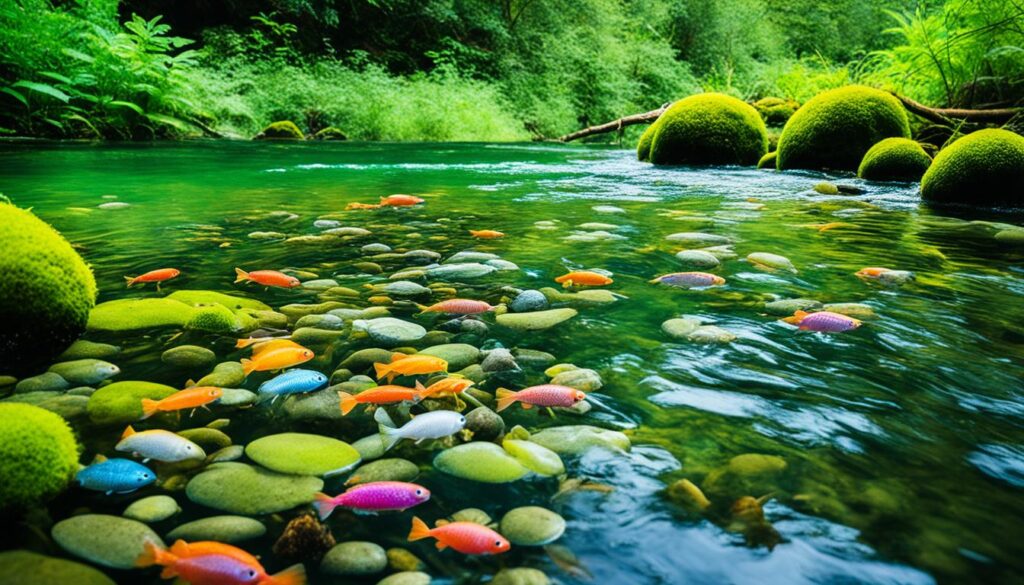
Through ongoing monitoring efforts, scientists can gain a better understanding of the status and trends of freshwater invertebrates. This knowledge is vital for effectively managing and conserving freshwater ecosystems, protecting water quality, and ensuring the long-term health of these unique and diverse habitats.
European Study on Temporal Trends in Freshwater Invertebrates
A recent European study delved into the fascinating world of freshwater invertebrates, analyzing over 1,800 time series of invertebrate communities across 22 countries. Spanning from 1968 to 2020, this comprehensive study provides valuable insights into the temporal trends of freshwater biodiversity.
The findings of the study revealed intriguing patterns in the richness and abundance of freshwater invertebrates. Over the years, there has been a notable increase in taxon richness, functional richness, and overall abundance. This suggests a positive trend in freshwater biodiversity, indicating that these ecosystems are home to a diverse array of invertebrate species.
However, the study also uncovered some concerning aspects. While the overall trend shows an increase in freshwater invertebrate populations, the rate of growth has slowed down in recent years. This plateau in biodiversity gains raises concerns about the long-term survival and conservation of these vital organisms.
Furthermore, the study highlighted specific areas that are particularly vulnerable to biodiversity loss. Freshwater communities downstream of dams, urban areas, and cropland showed limited recovery, indicating the ongoing impact of human activities on these ecosystems. Additionally, sites experiencing faster rates of warming exhibited fewer gains in biodiversity, emphasizing the need to address the effects of climate change on freshwater invertebrates.
The Need for Additional Mitigation Efforts
This European study serves as a powerful reminder of the importance of ongoing conservation efforts to combat the biodiversity loss faced by freshwater invertebrates. It underscores the need for additional mitigation measures to reverse the decline and revive freshwater biodiversity.
By implementing targeted conservation strategies, such as habitat restoration projects and pollution control measures, we can create a more favorable environment for freshwater invertebrates to thrive. Protecting pristine habitats, reducing pollution levels, and addressing the impacts of climate change are essential steps in safeguarding the future of these vital organisms and the ecosystems they inhabit.
The European study on temporal trends in freshwater invertebrates serves as a call to action, urging scientists, policymakers, and the public to come together and work towards the preservation of freshwater biodiversity. By understanding the challenges and opportunities presented by these findings, we can pave the way for a sustainable future, where freshwater invertebrates continue to play their critical roles in maintaining the health and balance of aquatic ecosystems.

The Role of Freshwater Invertebrates in Water Quality Assessment
Freshwater invertebrates play a crucial role in assessing and monitoring water quality in streams and rivers. These diverse organisms, such as insects, worms, and mollusks, can serve as indicators of the overall health of an aquatic ecosystem. By studying the presence and abundance of freshwater invertebrates, scientists can gain valuable insights into the impact of pollution and the state of stream health.
Freshwater Invertebrates as Bioindicators
One of the key reasons why freshwater invertebrates are valuable in water quality assessment is their varying tolerance levels to pollution. Different species have different sensitivities, with some being highly sensitive and only thriving in pristine conditions, while others are more tolerant and can survive in polluted environments. By observing which species are present and which are absent, researchers can assess the extent of pollution in a water body.
In general, a diverse community of freshwater invertebrates indicates good water quality and a healthy stream ecosystem. This is because various species occupy different ecological niches, performing different ecological functions within the ecosystem. Their presence signifies a balanced and well-functioning ecosystem.
Conversely, a decline in freshwater invertebrate diversity and abundance can suggest poor water quality and ecosystem degradation. Pollution, such as excessive nutrient runoff or chemical contamination, can negatively impact invertebrate populations, leading to a decrease in their numbers.
The Importance of Monitoring Freshwater Invertebrates
Regular monitoring of freshwater invertebrates is crucial for determining the effectiveness of pollution control measures and identifying areas that require further attention. Assessing the diversity and abundance of these organisms can provide insights into the current state of water quality, the impacts of pollution, and the overall health of a stream or river ecosystem.
Monitoring efforts typically involve collecting samples of freshwater invertebrates at various locations and analyzing the data. Scientists identify the species present, quantify their abundance, and assess their pollution tolerance. By comparing this information over time, they can track changes in the water quality and detect any trends or patterns.
The Role of Freshwater Invertebrates in Stream Health
Stream health is a vital component of overall ecosystem health. By monitoring the populations of freshwater invertebrates, scientists can gain insights into the condition of a stream and its ability to support diverse aquatic life. Variations in the composition and abundance of invertebrate communities can indicate specific issues, such as pollution, habitat degradation, or changes in water flow.
For example, if pollution levels increase in a stream, sensitive invertebrate species may decline or disappear, leaving behind more pollution-tolerant species. Additionally, changes in the flow or temperature of a stream can affect the distribution and abundance of invertebrates, further impacting stream health. By studying these dynamics, researchers can identify potential threats and guide conservation efforts to restore and protect stream ecosystems.
Examples of Freshwater Invertebrates and Their Pollution Tolerance
| Freshwater Invertebrate | Pollution Tolerance |
|---|---|
| Stonefly nymphs | Highly sensitive to pollution |
| Mayfly nymphs | Highly sensitive to pollution |
| Caddisfly larvae | Moderately sensitive to pollution |
| Dragonfly nymphs | Less sensitive to pollution |
| Scuds | Tolerant of pollution |
| Leeches | Highly tolerant of pollution |
Understanding the pollution tolerance of different freshwater invertebrates is crucial for assessing the severity of pollution in a water body. The table above provides examples of some common freshwater invertebrates and their pollution tolerance levels, ranging from highly sensitive to highly tolerant.

By carefully studying and monitoring the diversity and abundance of freshwater invertebrates, scientists and conservationists can make informed decisions and take necessary actions to ensure the protection and restoration of water quality and stream health. The preservation of these remarkable organisms is not only essential for maintaining ecosystem balance but also for safeguarding the overall well-being of our aquatic environments.
Conservation Strategies for Freshwater Invertebrates
To ensure the survival and well-being of freshwater invertebrates, it is crucial to implement effective conservation strategies. These strategies encompass habitat restoration, pollution control measures, and public education. By proactively addressing these aspects, we can protect these valuable organisms and the ecosystems they inhabit.
Habitat Restoration
Habitat restoration projects play a vital role in creating suitable environments for freshwater invertebrates. Some key initiatives include the removal of dams or the restoration of natural stream channels. These actions help improve water flow, increase oxygen levels, and provide better conditions for invertebrate communities to thrive. Restoring the natural habitat not only benefits the invertebrates but also contributes to overall ecosystem health.
Pollution Control
Addressing water pollution is critical for conserving freshwater invertebrates. Implementing pollution control measures, such as wastewater treatment and reducing agricultural runoff, can help maintain or restore water quality. By minimizing the impact of pollutants on aquatic ecosystems, we can safeguard the health and diversity of invertebrate populations. It is essential to regulate and manage pollution sources to ensure long-term conservation success.
Public Education

Educating the public about the importance of freshwater invertebrates and their role in ecosystem health is crucial for conservation efforts. By raising awareness and fostering a sense of stewardship, we can inspire individuals to participate in protecting these organisms. Public education initiatives can involve workshops, educational materials, and hands-on activities, empowering communities to contribute to freshwater invertebrate conservation.
Table: An Overview of Conservation Strategies for Freshwater Invertebrates
| Conservation Strategies | Description |
|---|---|
| Habitat Restoration | Removing dams and restoring natural stream channels to create favorable habitats for invertebrates. |
| Pollution Control | Implementing measures to treat wastewater and reduce agricultural runoff, preserving water quality. |
| Public Education | Educating the public about the importance of freshwater invertebrates and promoting stakeholder involvement. |
Citizen Science and Freshwater Invertebrate Conservation
Citizen science initiatives have revolutionized freshwater invertebrate conservation by harnessing the power of public participation. By involving individuals, schools, and communities in biodiversity monitoring, researchers can gather large-scale data for effective conservation efforts.
Citizen science projects provide a unique opportunity for people to contribute to the preservation of freshwater invertebrates. Participants can actively engage in hands-on activities, such as collecting data on invertebrate communities in rivers, lakes, and ponds.
This collaborative approach not only enhances scientific research but also raises awareness about the importance of freshwater invertebrates and their role in maintaining ecosystem health. By immersing themselves in conservation efforts, citizens develop a deeper connection with their local environments and become more invested in protecting these fragile ecosystems.
“Citizen science projects enable everyone to become a scientist, fostering a sense of empowerment and inspiring a new generation of environmental stewards,” says Dr. Sarah Thompson, a freshwater ecologist at the Water Institute.
“Engaging citizens in biodiversity monitoring expands the reach and scope of research. The valuable data collected by citizen scientists provides insights into the distribution, abundance, and health of freshwater invertebrate populations, enabling us to make informed conservation decisions,” adds Dr. Thompson.
Furthermore, citizen science initiatives facilitate the exchange of knowledge between scientists and the general public. Through participation in workshops, educational programs, and community events, citizens gain a deeper understanding of freshwater invertebrates and the principles of conservation.
“Citizen science plays a critical role in strengthening the bridge between science and society. By collaborating with communities, we can collectively address conservation challenges and work towards a sustainable future,” highlights Dr. Thompson.
To showcase the impressive impact of citizen science, take a look at the following examples:
| Project | Description |
|---|---|
| Creek Watch | A smartphone app that allows users to monitor water quality and report pollution incidents, providing valuable data for policymakers and water management agencies. |
| Great Lakes Worm Watch | A community-driven project that engages volunteers in monitoring earthworm populations in the Great Lakes region, providing insights into the impacts of invasive species. |
| Dragonfly Swarm Project | Citizens contribute observations of dragonfly swarms to this project, helping researchers understand the migration patterns and behaviors of these fascinating creatures. |
The Power of Collaboration
The success of citizen science in freshwater invertebrate conservation lies in the power of collaboration. When scientists and citizens work together, they can achieve far-reaching goals that would be impossible to accomplish alone.
“By combining scientific expertise and local knowledge, citizen science initiatives create a dynamic synergy that drives meaningful change,” explains Dr. Thompson.
Citizen science has proven to be an effective approach in monitoring freshwater invertebrates, collecting valuable data, and fostering a sense of ownership and responsibility among participants. Through their active involvement, citizens become advocates for freshwater conservation, leading to a brighter future for these fragile ecosystems.
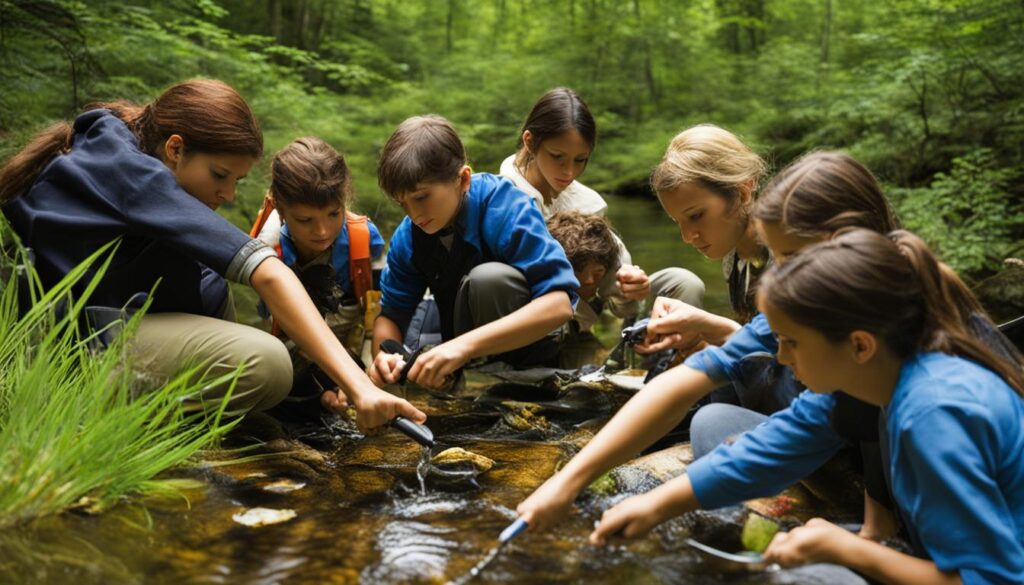
Future Challenges and Opportunities in Freshwater Invertebrate Conservation
Freshwater invertebrate conservation faces a unique set of challenges and opportunities. As the impacts of climate change intensify, these organisms are increasingly vulnerable to environmental disruptions. The introduction of emerging pollutants and invasive species further threatens their survival. However, advancements in technology and scientific knowledge offer new opportunities for better understanding and conservation.
Researchers can leverage DNA analysis, remote sensing, and modeling techniques to assess the distribution and abundance of freshwater invertebrates. These tools enable precise and comprehensive data collection, providing valuable insights into their population dynamics. Understanding the intricacies of their habitats and population trends is essential for implementing effective conservation strategies.
Collaboration among scientists, policymakers, and the public is crucial for addressing the conservation challenges faced by freshwater invertebrates. By sharing knowledge, expertise, and resources, it becomes possible to develop innovative approaches that promote their long-term survival. This collaborative effort aims to protect not only the diverse range of species but also the delicate balance of aquatic ecosystems they inhabit.
“Conserving freshwater invertebrates requires a multidisciplinary approach, involving not only researchers but also policymakers, conservation organizations, and the general public. We must work together to mitigate the threats posed by climate change, invasive species, and pollution and ensure the preservation of these valuable organisms for future generations.” – Dr. Amanda Roberts, Freshwater Ecologist
As climate change poses an increasing threat, understanding the specific vulnerabilities of freshwater invertebrates becomes crucial. Rising temperatures, altered precipitation patterns, and changes in water availability can disrupt their habitats and life cycles. Conserving these organisms requires proactive measures to mitigate the impacts of climate change and improve their resilience.
Moreover, the conservation of freshwater invertebrates is not merely an ecological imperative but an ethical responsibility. These organisms are vital components of aquatic ecosystems, ensuring water quality, nutrient cycling, and the stability of entire food webs. By protecting freshwater invertebrates, we safeguard the services they provide, benefiting both the environment and human well-being.
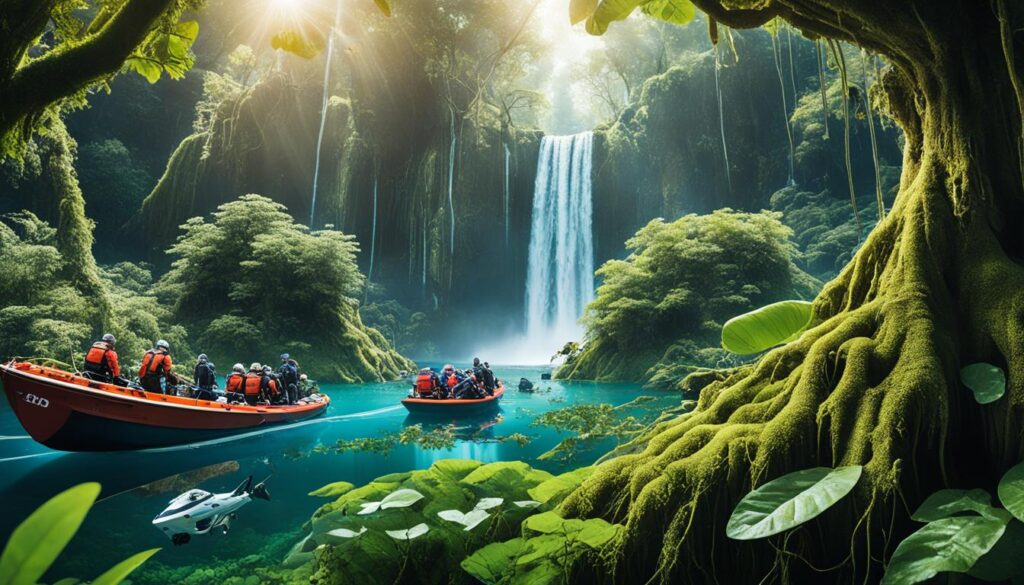
The Role of Citizen Science
Citizen science initiatives offer a promising avenue for freshwater invertebrate conservation. Empowering individuals, schools, and communities to participate in biodiversity monitoring not only increases public awareness but also generates valuable data on these organisms. Engaging citizens in hands-on conservation efforts fosters a sense of stewardship and a deeper understanding of the importance of freshwater invertebrates.
The Importance of Adaptation
Adapting conservation strategies to the ever-evolving challenges is paramount for the long-term survival of freshwater invertebrates. As new threats emerge, conservationists must remain flexible and responsive. By continuously reassessing and refining strategies, they can effectively address emerging issues and ensure the ongoing conservation of these vital organisms.
Addressing Knowledge Gaps
While significant progress has been made in understanding freshwater invertebrates, there is still much to learn. Research efforts must continue to fill knowledge gaps and enhance our understanding of their ecological roles and specific conservation needs. By investing in research and monitoring programs, we can refine conservation strategies and protect these vulnerable organisms more effectively.
The Role of Freshwater Invertebrates in Ecosystem Services
Freshwater invertebrates play a vital role in providing essential ecosystem services that directly impact human well-being. These small organisms contribute significantly to water quality, nutrient cycling, food webs, and serve as indicators of ecosystem health and functioning.
One of the crucial ecosystem services provided by freshwater invertebrates is their ability to filter out pollutants from the water. These organisms act as natural water purifiers, removing harmful substances and improving water quality. Through their feeding activities, they help to reduce nutrient pollution, such as excess phosphorus and nitrogen, which can lead to eutrophication.
Additionally, freshwater invertebrates contribute to nutrient cycling by decomposing organic matter, such as leaves, twigs, and dead organisms, in aquatic ecosystems. They break down these materials and release nutrients back into the water, making them available to other organisms. This process ensures the overall productivity of the ecosystem and helps maintain a healthy balance in nutrient levels.
Freshwater invertebrates also serve as a vital food source for other organisms, including fish, amphibians, and birds. They form the base of the food web, transferring energy from lower trophic levels to higher ones. The abundance and diversity of invertebrates in a water body directly influence the availability of food resources for higher-level predators.
Furthermore, freshwater invertebrates act as indicators of overall ecosystem health. Changes in their population size, diversity, and composition can reflect alterations in water quality, habitat conditions, and pollution levels. Monitoring the presence and abundance of these organisms can provide valuable insights into the ecological status of a water body and the effectiveness of conservation efforts.
“Freshwater invertebrates play a vital role in maintaining water quality, nutrient cycling, and food webs, making them integral to healthy aquatic ecosystems. Their presence and abundance serve as important indicators of ecosystem health and provide invaluable insights into the overall well-being of freshwater environments.”
By recognizing the importance of freshwater invertebrates in providing ecosystem services, we can guide and inform effective conservation strategies. Protecting and preserving these organisms and their habitats is crucial for maintaining water quality, sustaining biodiversity, and ensuring the long-term functioning of freshwater ecosystems.
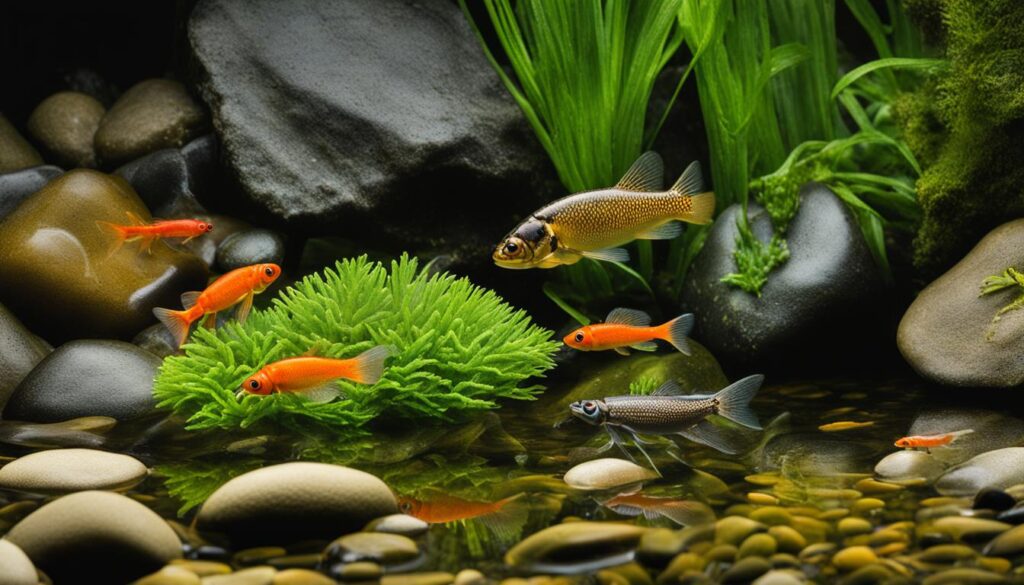
Education and Awareness for Freshwater Invertebrate Conservation
Education and awareness initiatives play a crucial role in freshwater invertebrate conservation. By promoting the understanding of the importance of these organisms and their connection to ecosystem health, conservation organizations can foster a sense of environmental stewardship. Outreach programs, workshops, and educational materials can engage individuals of all ages and backgrounds, creating a collective effort towards freshwater invertebrate conservation.
Engaging the Community
One of the key strategies for promoting education and awareness is to engage the community in conservation efforts. By organizing workshops, field trips, and community events, individuals can learn about the fascinating world of freshwater invertebrates and the need to protect their habitats. These activities provide hands-on learning experiences and foster a sense of connection and empathy towards these often overlooked creatures.
Raising Awareness in Schools
An important target audience for freshwater invertebrate education is schools. By incorporating lessons and activities about freshwater ecosystems and the role of invertebrates, children can develop a lifelong appreciation for these organisms and a commitment to their conservation. Science classes can include experiments and observations of live invertebrates, while art and writing classes can explore creative ways to raise awareness about their importance.
Collaboration with Conservation Organizations
Conservation organizations play a critical role in driving education and awareness initiatives. These organizations can collaborate with schools, universities, and local communities to develop educational resources, including brochures, posters, and online materials. They can also organize training sessions for teachers, providing them with the tools and knowledge to incorporate freshwater invertebrate conservation into their curricula.
“Education is the most powerful weapon which you can use to change the world.” – Nelson Mandela
Digital Outreach and Online Resources
The digital age provides numerous opportunities for education and awareness. Conservation organizations can create engaging websites, interactive games, and virtual tours that allow individuals to explore the world of freshwater invertebrates from the comfort of their homes. Online resources, such as videos, podcasts, and webinars, can also reach a broader audience and spread knowledge about the importance of these organisms.
Collaborations with Research Institutions
Collaborating with research institutions can enhance education and awareness efforts. Scientists and researchers can share their expertise through outreach programs and public lectures, enlightening audiences about their discoveries and the value of freshwater invertebrates. By showcasing the latest research findings, these collaborations inspire curiosity and encourage individuals to get involved in conservation efforts.
The Power of Social Media
Social media platforms offer a powerful tool for reaching a wide audience. Conservation organizations can leverage platforms such as Facebook, Instagram, and Twitter to share educational content, conservation success stories, and updates on ongoing projects. Engaging and interactive posts can encourage individuals to share information with their networks, amplifying the reach and impact of freshwater invertebrate conservation outreach.
By combining these various education and awareness strategies, conservation organizations can inspire individuals to take action and contribute to the conservation of freshwater invertebrates and their habitats.
Conclusion
Freshwater invertebrates are crucial for the health and balance of aquatic ecosystems. They contribute to maintaining water quality, nutrient cycling, and overall ecosystem functioning. Monitoring the diversity and abundance of these fascinating creatures provides valuable insights into the condition of aquatic ecosystems and the effectiveness of conservation efforts.
To protect and conserve freshwater invertebrates, it is essential to address the threats they face. Implementing conservation strategies such as habitat restoration and pollution control can help create healthier environments for these organisms. Additionally, educating the public about the importance of freshwater invertebrates and their roles in ecosystem health fosters a sense of stewardship and contributes to conservation efforts.
By taking collective action and raising awareness, we can ensure the future preservation of freshwater invertebrates and the biodiversity they represent. Conservation of these organisms is not only essential for the well-being of aquatic ecosystems but also for our own well-being as they provide valuable ecosystem services. Let us work together to protect and conserve these incredible creatures and the vital ecosystems they call home.
